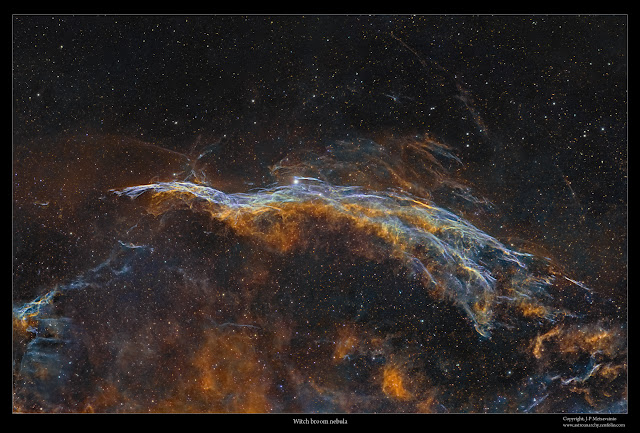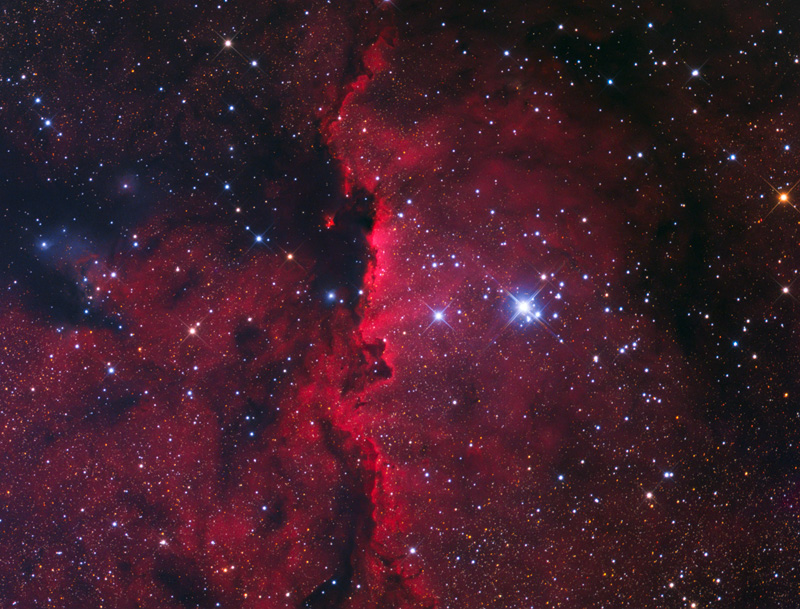Page 2 of 3
Re: Found images: 2015 November
Posted: Sat Nov 14, 2015 5:39 pm
by starsurfer
Keenan's System (Arp 104)
http://www.noao.edu/image_gallery/html/im1270.html
Copyright: T.A. Rector (University of Alaska Anchorage) and H. Schweiker (WIYN and NOAO/AURA/NSF)
HEIC: A Young Elliptical (NGC 3610)
Posted: Mon Nov 16, 2015 4:27 pm
by bystander
A Young Elliptical (NGC 3610)
ESA Hubble Picture of the Week | 2015 Nov 16
At the centre of this amazing image is the elliptical galaxy
NGC 3610. Surrounding the galaxy are a wealth of other galaxies of all shapes. There are spiral galaxies, galaxies with a bar in their central regions, distorted galaxies and elliptical galaxies, all visible in the background. In fact, almost every bright dot in this image is a galaxy — the few foreground stars are clearly distinguishable due to the diffraction spikes that overlay their images.
NGC 3610 is of course the most prominent object in this image — and a very interesting one at that! Discovered in 1793 by William Herschel, it was later found that this elliptical galaxy contains a disc. This is very unusual, as discs are one of the main distinguishing features of a spiral galaxy. And NGC 3610 even hosts a memarkable bright disc.
The reason for the peculiar shape of NGC 3610 stems from its formation history. When galaxies form, they usually resemble our galaxy, the Milky Way, with flat discs and spiral arms where star formation rates are high and which are therefore very bright. An elliptical galaxy is a much more disordered object which results from the merging of two or more disc galaxies. During these violent mergers most of the internal structure of the original galaxies is destroyed. The fact that NGC 3610 still shows some structure in the form of a bright disc implies that it formed only a short time ago. The galaxy’s age has been put at around four billion years and it is an important object for studying the early stages of evolution in elliptical galaxies.
Re: Found images: 2015 November
Posted: Tue Nov 17, 2015 6:31 pm
by starsurfer
Re: Found images: 2015 November
Posted: Tue Nov 17, 2015 6:36 pm
by starsurfer
Re: Found images: 2015 November
Posted: Tue Nov 17, 2015 6:38 pm
by starsurfer
Re: Found images: 2015 November
Posted: Wed Nov 18, 2015 4:30 pm
by Ann


Adam Block has posted two new galaxy images, NGC 6118 and NGC 918.
Full size images can be seen at
caelumobservatory.com.
Ann
Re: Found images: 2015 November
Posted: Wed Nov 18, 2015 6:38 pm
by starsurfer
Ann wrote:

Adam Block has posted two new galaxy images, NGC 6118 and NGC 918.
Full size images can be seen at
caelumobservatory.com.
Ann
I saw these a few days ago and they're amazing! Also congratulations on including images in a post!
However you haven't included my favourite, which is a new version of Arp 104, Keenan's System!
Re: Found images: 2015 November
Posted: Wed Nov 18, 2015 7:18 pm
by starsurfer
Re: Found images: 2015 November
Posted: Thu Nov 19, 2015 1:56 am
by Ann
starsurfer wrote:Ann wrote:

Adam Block has posted two new galaxy images, NGC 6118 and NGC 918.
Full size images can be seen at
caelumobservatory.com.
Ann
I saw these a few days ago and they're amazing! Also congratulations on including images in a post!
However you haven't included my favourite, which is a new version of Arp 104, Keenan's System!

Here is Keenan's System.
The most remarkable aspect of this interacting pair is the "thread" connecting them. But to me, the most noteworthy thing is that the galaxy at top, NGC 5218, has recently (say, a billion years ago) undergone a tremendous burst of star formation that likely drove most of the starforming gas out of the galaxy. (Tidal forces caused by its interaction with elliptical NGC 5216 also helped driving out gas from NGC 5218.) Therefore NGC 5218 has a rich, brilliant, smoothly distributed population of stars of spectral class A (and possibly late B), a spectacular remnant of its past starburst, but hardly any O-stars any more. NGC 5218 is likely in transition into into a "red and dead", elliptical galaxy.
Full resolution of the image can be seen
here.
Ann
Re: Found images: 2015 November
Posted: Thu Nov 19, 2015 6:43 pm
by starsurfer
Ann wrote:starsurfer wrote:Ann wrote:

Adam Block has posted two new galaxy images, NGC 6118 and NGC 918.
Full size images can be seen at
caelumobservatory.com.
Ann
I saw these a few days ago and they're amazing! Also congratulations on including images in a post!
However you haven't included my favourite, which is a new version of Arp 104, Keenan's System!

Here is Keenan's System.
The most remarkable aspect of this interacting pair is the "thread" connecting them. But to me, the most noteworthy thing is that the galaxy at top, NGC 5218, has recently (say, a billion years ago) undergone a tremendous burst of star formation that likely drove most of the starforming gas out of the galaxy. (Tidal forces caused by its interaction with elliptical NGC 5216 also helped driving out gas from NGC 5218.) Therefore NGC 5218 has a rich, brilliant, smoothly distributed population of stars of spectral class A (and possibly late B), a spectacular remnant of its past starburst, but hardly any O-stars any more. NGC 5218 is likely in transition into into a "red and dead", elliptical galaxy.
Full resolution of the image can be seen
here.
Ann
Thank you so much, you're so nice! You've made me so happy!


Re: Found images: 2015 November
Posted: Thu Nov 19, 2015 7:13 pm
by starsurfer
Re: Found images: 2015 November
Posted: Thu Nov 19, 2015 11:32 pm
by Glima49
NGC 6960, the Witch's Broom Nebula
http://www.astroanarchy.blogspot.fi/201 ... ebula.html
Credit and copyright: J-P Metsavainio (
Astro Anarchy)

Re: Found images: 2015 November
Posted: Fri Nov 20, 2015 2:54 pm
by starsurfer
NGC 6744
http://www.astrobin.com/189640/
Copyright: Geoff Smith
ESO: Laser Vision
Posted: Mon Nov 23, 2015 4:33 pm
by bystander
Laser Vision
ESO Picture of the Week | 2015 Nov 23
[c][attachment=0]potw1547a[1].jpg[/attachment][/c][hr][/hr]
This image shows one of the four
Unit Telescopes that make up ESO’s Very Large Telescope (
VLT) at Paranal. Each of the 8.2-metre telescopes was given a name in the
Mapuche language spoken by indigenous people from the Southern Chile. The Unit Telescope in this image is called
Yepun, which means Venus.
The smaller telescope beside Yepun is one of four
Auxiliary Telescopes that have a diameter of 1.8 metres. These can be combined with the Unit Telescopes to make the Very Large Telescope Interferometer (
VLTI).
Yepun is equipped with the
Laser Guide Star Facility that is caught in action in this picture. The laser beam’s colour is precisely tuned to energise a layer of sodium atoms in the atmosphere which creates a small bright spot — an artificial star. This star can be used as a reference to work out how much the atmosphere is distorting the light from actual stars — a process called
adaptive optics — which helps to develop clear images.
Above Yepun you can see part of the
Milky Way galaxy stretching across the southern sky. The brighter regions on the lower right correspond to the
Large Magellanic Cloud and
Small Magellanic Cloud — two satellite galaxies of the Milky Way.
HEIC: The Last Waltz
Posted: Mon Nov 23, 2015 4:50 pm
by bystander
The Last Waltz
ESA Hubble Picture of the Week | 2015 Nov 23
This curious galaxy — only known by the seemingly random jumble of letters and numbers
2MASX J16270254+4328340 — has been captured by the NASA/ESA Hubble Space Telescope dancing the crazed dance of a
galactic merger. The galaxy has merged with another galaxy leaving a fine mist, made of millions of stars, spewing from it in long trails.
Despite the apparent chaos, this snapshot of the gravitational tango was captured towards the event’s conclusion. This transforming galaxy is heading into old age with its star-forming days coming to an end. The true drama occurred earlier in the process, when the various clouds of gas within the two galaxies were so disturbed by the event that they collapsed, triggering an eruption of
star formation. This flurry of activity exhausted the vast majority of the galactic gas, leaving the galaxy sterile and unable to produce new stars.
As the violence continues to subside, the newly formed galaxy’s population of stars will redden with age and eventually begin drop off one by one. With no future generations of stars to take their place, the galaxy thus begins a steady descent towards death.
Re: HEIC: The Last Waltz
Posted: Mon Nov 23, 2015 7:50 pm
by starsurfer
bystander wrote:The Last Waltz
ESA Hubble Picture of the Week | 2015 Nov 23
This curious galaxy — only known by the seemingly random jumble of letters and numbers
2MASX J16270254+4328340 — has been captured by the NASA/ESA Hubble Space Telescope dancing the crazed dance of a
galactic merger. The galaxy has merged with another galaxy leaving a fine mist, made of millions of stars, spewing from it in long trails.
Despite the apparent chaos, this snapshot of the gravitational tango was captured towards the event’s conclusion. This transforming galaxy is heading into old age with its star-forming days coming to an end. The true drama occurred earlier in the process, when the various clouds of gas within the two galaxies were so disturbed by the event that they collapsed, triggering an eruption of
star formation. This flurry of activity exhausted the vast majority of the galactic gas, leaving the galaxy sterile and unable to produce new stars.
As the violence continues to subside, the newly formed galaxy’s population of stars will redden with age and eventually begin drop off one by one. With no future generations of stars to take their place, the galaxy thus begins a steady descent towards death.
I love these detailed HST images of obscure peculiar galaxies, it's always nice to see something completely new and unfamiliar!
Re: Found images: 2015 November
Posted: Mon Nov 23, 2015 7:52 pm
by starsurfer
NGC 3621
http://www.eso.org/public/images/eso1104a/
Copyright: ESO and Joe DePasquale
Re: Found images: 2015 November
Posted: Mon Nov 23, 2015 7:58 pm
by starsurfer
NGC 474
http://www.martinpughastrophotography.id.au
Copyright: Martin Pugh
NGC 474 is the large shell elliptical galaxy. The spiral galaxy to the left of it is NGC 470 and the galaxy with tidal plumes is NGC 467.
Re: Found images: 2015 November
Posted: Mon Nov 23, 2015 8:04 pm
by starsurfer
Sh2-150 and vdB154
http://www.astroimager.net/Page-130GT-CCD-319.html
Copyright: Jim Janusz
Sh2-150 is the elongated emission nebula and vdB154 is the reflection nebula below it.
Re: Found images: 2015 November
Posted: Tue Nov 24, 2015 6:33 pm
by starsurfer
M53 and NGC 5053
http://bf-astro.com/m53fsq/m53.htm
Copyright: Bob Franke
This might be the only pairing of globular clusters in the northern sky!
Re: Found images: 2015 November
Posted: Tue Nov 24, 2015 9:04 pm
by Glima49
Re: Found images: 2015 November
Posted: Wed Nov 25, 2015 2:50 pm
by starsurfer
Re: Found images: 2015 November
Posted: Thu Nov 26, 2015 6:34 pm
by starsurfer
Re: Found images: 2015 November
Posted: Fri Nov 27, 2015 3:25 pm
by starsurfer
ESO: Starbirth over ALMA (Carina Nebula)
Posted: Mon Nov 30, 2015 2:47 pm
by bystander
Starbirth over ALMA
ESO Picture of the Week | 2015 Nov 30
In this wonderful high definition, singe-exposure image taken during the
ESO Ultra HD Expedition, three deep sky objects seem to shine in front of the dish of one of the Atacama Large Millimeter/submillimeter Array (
ALMA) high-precision antennas.
The most striking feature is the reddish
Carina Nebula, also known as NGC 3372. It is a
large cloud of gas, mostly hydrogen, in which star formation has recently taken place. The short-lived massive blue stars forged within the nebula emit copious amounts of ultraviolet radiation, which then ionises the surrounding gas and causes the hydrogen atoms to glow with a characteristic
red colour. Eventually supernova explosions and strong stellar winds from the most massive stars will disperse the gas of the
Carina Nebula, leaving behind one or more clusters of stars.
Two such star clusters, known as
NGC 3532 and
IC 2602, can be seen respectively to the top right and top left of the Carina Nebula in this image.
The three celestial objects belong to the constellation of
Carina (
The Keel) and were first catalogued by the French astronomer
Nicolas Louis de Lacaille. They look close to one another in this image, but actually their distances from us are very different.
IC 2602 lies less than 500 light-years from Earth,
NGC 3532 is around 1300 light-years away and the
Carina Nebula is thought to lie up to 10 000 light-years away.



 Adam Block has posted two new galaxy images, NGC 6118 and NGC 918.
Adam Block has posted two new galaxy images, NGC 6118 and NGC 918. Here is Keenan's System.
Here is Keenan's System.

